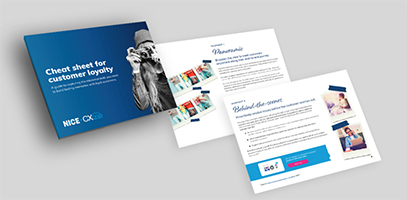“How may I hinder you?” That’s what customer service in the airline industry can feel like at times. Airlines have struggled with customer service and overall customer experience, but recently these struggles have hit new highs. Airlines furloughed much of their staff when travel all but came to a grinding halt at the height of the pandemic. Many airlines were unprepared for the swift travel rebound in the summer of 2021, and now, the 2022 travel season is upon us in full force.
What’s been going on behind the scenes since travel resumed? Excessive flight delays, cancellations, customer service wait times of over nine hours, and terrible, horrible, no good, very bad CX. And what comes of such dire circumstances? A perfect storm of issues: staffing shortages, a shrinking labor pool that affects new employee recruiting, and current employees that are overwhelmed with service requests. All of this adversely affects the customer experience.
October 2021 was the peak cancellation month that year: Southwest alone cancelled 1800 flights one weekend.[i] Savvy travelers cope with the changes better. When my husband’s flight was cancelled, he ran to the next gate and managed to get a different flight home that day. His luggage, on the other hand, only made it to Chicago… but that’s another story. Inexperienced travelers in the same position might have spent a good chunk of time waiting on hold with customer service.
Compounding the problems are passengers and staff suffering from pandemic stress, leading to more angry confrontations than ever before. As of September 2021, the FAA had initiated 750 investigations into unruly passengers for the year. In all of 2019, there were only 146 cases.[ii]
In times of stress, endurance and adaptability is key. Airlines can't control the weather, but they can control the quality of their customer service, including wait times. Recent headlines about hour-long hold times and other customer experience failures have been brutal for airlines, but there has also been positive news of progress. Both types of headlines, including the following, can teach valuable lessons to all CX professionals regardless of industry.
Lesson 1: Are you able to deliver on customer expectations?
Headline: “Southwest Airlines cancels 1,800 flights, blaming weather and staffing”
Airline customers expect to reach their final destinations on time. That—and maybe a tiny bag of pretzels—is the primary customer expectation. For a company like Southwest, who is known for its stellar on-time record and friendly customer experience, this must have been a painful incident. In fact, it led to another headline:
“A Message from President & COO Mike Van de Ven”
The president of Southwest issued a sincere apology and provided a detailed, logical explanation of what went wrong, but that likely didn’t matter much to customers whose travel plans were ruined.
Granted, airlines have a complex service to deliver, and a lot can go wrong, but customers don't have many (or any) competitors to turn to when they've had enough.
Businesses that don't have the luxury of a near monopoly must consistently meet customer expectations no matter the circumstances. This requires agility and business resiliency.
For contact centers that are finely tuned to have just the right number of agents, a business disruption, such as what the travel industry is experiencing, can be difficult to absorb if the right solutions aren't in place. Contact centers that can effectively weather disruptions have:
- Flexible, cloud-based call center solutions
- Work from home capabilities (enabled by the cloud)
- Effective self-service options that decrease the demand for agent assistance
- The ability to quickly make configuration changes to automatic call distributors (ACDs) and interactive voice response (IVR)
In the ever-changing world of customer service, one constant is that disruptions happen. Contact centers that are prepared to continue to meet customer expectations even when the world throws them a curve ball successfully maintain customer loyalty. depends on it.
This cheat sheet offers tips on how to improve CX and maintain satisfaction when disruptions (like the pandemic) or tech advancements occur.
Get the Cheat Sheet for Customer Loyalty
Lesson 2: Are you proactively addressing failure to meet customer expectations?
Headline: “We know you expect more – we’re taking action: Your update from Ed”
Ed happens to be Ed Bastien, Delta Air Lines CEO. In this message, which was sent to millions of customers, he outlines what the company plans to do to improve customer service experiences. Solutions include hiring more contact center agents and adding more self-service functionality to Delta's mobile app.
This headline might seem fine and the solutions appropriate, but the story is a bit different from three months ago:
“Follow These Tips to Cut Down on Long Wait Times with Airline Phone Reps”
Delta is one of the airlines cited for long customer wait times, so on the surface, the time gap between the two headlines make Delta appear to be passive in addressing in its customer service issues.
Contact centers have plenty of warning systems to let them know things are heading south. Negative trends in service levels, abandon rates, first contact resolution rates, satisfaction scores, and other KPIs let customer service leaders know there's an issue that needs to be addressed. Then, it's a matter of identifying and fixing the root cause.
For better problem management, contact centers can leverage interaction analytics software. This AI-powered solution analyzes every interaction from every channel and provides insights about contact drivers and emerging issues. This information empowers business leaders to identify sources of issues and proactively nip them in the bud.
To learn how to identify and avoid common contact center problems, delve into the eBook The top 5 pitfalls that lead to unhappy customers.
Lesson 3: Do you have enough staff to meet customer demands? Is your system’s routing optimized for agents to handle high volume?
Headline: “275 Minutes on Hold: Why Airline Customer Service Still Can’t Keep Up”
A combination of staffing shortages and a higher number of more complex transactions (using vouchers, rescheduling canceled flights, etc.) have led to persistently astronomical wait times. At least one airline customer poked fun of her hold time ordeal in a TikTok video.
But for most customers, waiting for hours to talk to a contact center agent is no laughing matter.
Agent shortages are rooted in the pandemic, when airlines greatly reduced their agent forces. The New York Times reports that almost 400 Southwest agents opted for voluntary severance while 25% of American Airlines representatives chose to leave. Additionally, Delta Air Lines' agent staffing levels were down 50%.[iii]
In other words, the reservation agent workforce was decimated.
Reducing staffing levels when customer demand is extremely low and the future is uncertain makes good business sense, but it seems like airlines were slow to staff up once people started flying again. Was a slow ramp-up also a business decision? Or did airlines just miss the early warning signals?
Low ASAs (average speed to answer) are essential to providing superior customer service experiences. In fact, Salesforce research revealed that 83% of customers expect to engage with someone immediately when reaching out to a business—a five-point increase from the prior year.[iv]
Today's consumers expect instant gratification, and not providing it can negatively impact customer loyalty. This means businesses need to be hyper-aware of volume trends that indicate hiring more contact center agents is in order. This is especially true when new agents will have a long learning curve.
Businesses don't need to hire when volume spikes are temporary, but they should have plans in place to soften the blow on service levels. For example, routing customers to channels with the lowest queue times can help ensure customers don't wait longer than necessary.
Lesson 4: Are you using automation and AI to its full potential?
Headline: “Customer Experience in the Age of AI”
Artificial intelligence (AI) is transforming customer experience in all verticals, including the airline industry. The recently published article associated with this headline provides a positive example of how Australian-based Qantas Airlines is creatively using AI to improve CX.
Qantas leverages artificial intelligence to personalize booking, check-in, and in-flight experiences for its customers. "For example, its app makes real-time recommendations according to where the passenger is, such as how to check in most efficiently, what time to leave for the airport, and the best route to take."[v]
For customer service, many airlines are also using AI-powered virtual agents to make self-service more effective.
Contact centers can also use the power of AI to:
- Make forecasts and schedules more accurate
- Improve customer-agent matching through smart, data-driven routing
- Provide soft skill coaching to agents while interactions are taking place
- Analyze 100% of interactions from all channels to identify customer sentiment, call drivers, emerging issues, potential compliance problems, and more
In addition to AI, airlines can also leverage automation to meet customer expectations. Automation can increase agent capacity by reducing handle times, which is particularly helpful when volume and wait times are high and contact centers are understaffed.
With automation, agents can hand off repetitive, rule-based tasks such as changing information in multiple systems and sending email confirmations. This ultimately saves valuable time, enables them to handle more interactions, and provides them with the ability to focus more energy on connecting with customers.
Lesson 5: Are you optimized in your customer's preferred channels?
Headline: “PAL implements Amadeus’ self-service tool for flight disruptions”
How about we shake things up with a positive headline? Kudos to Philippine Airlines (PAL) for empowering customers to rebook their own flights rather than being required to contact customer service (and possibly face long wait times). According to the article, 160,000 passengers with flight disruptions benefited from the self-service solution within the first seven months following implementation.[vi]
All airlines offer some form of self-service. For example, it's a common practice to allow customers to book flights and check flight status online and through mobile apps.
But there's some evidence that airlines aren't fully leveraging the potential of self-service. As an example, there are limits placed on what customers can do when they rebook flights themselves. Additionally, Southwest Air's new CEO, Robert Jordan, said of upcoming plans in a recent interview, "Can you do everything that you need to do as a customer to self-serve for yourself on your phone?"[vii], implying that there might be room to improve their self-service options.
Focusing on self-service is a smart move. It would certainly relieve overflowing phone queues and provide more features for customers who prefer to self-serve. But businesses should also offer and optimize other preferred channels. For example, while researching for this article, I came across several passenger accounts who felt that Twitter response times were faster than phone support. (That might be because a well-written, scathing Tweet might go viral and get shared thousands of times…) It’s a fact that customers use multiple channels when seeking support, and all of them should be fully optimized.
This past year has been a roller coaster for airlines and their customers. All CX professionals can learn valuable lessons from recent headlines. Customers shouldn't need to play channel roulette to find help. Good planning, flexible technology, and heeding early warning signs can help contact centers in all industries gracefully handle disruptions.
Learn more about handling contact center volume swings
In times of uncertainty, businesses need to be agile when reacting to unexpected demand swings. Contact centers can rely on best practices to effectively handle volume spikes so that the impact to CX is minimized.
Check out "Demand Swings bundle LP (Travel and hospitality variations)" to access additional insights.
[i] CNBC: Southwest Airlines cancels 1,800 flights, blaming weather and staffing (2021)
[ii] The Wall Street Journal: Adults Are Throwing Tantrums—in Restaurants, Planes, and at Home. Blame the Pandemic. (2021)
[iii] The New York Times: 275 Minutes on Hold: Why Airline Customer Service Still Can’t Keep Up (2021)
[iv] Salesforce: State of the Connected Consumer, 4th Edition (2020)
[v] Harvard Business Review: Customer Experience in the Age of AI (2022)
[vi] TTG Asia: PAL implements Amadeus’ self-service tool for flight disruptions (2022)
[vii] ABC News: Incoming CEO at Southwest Air faces numerous challenges (2022)





